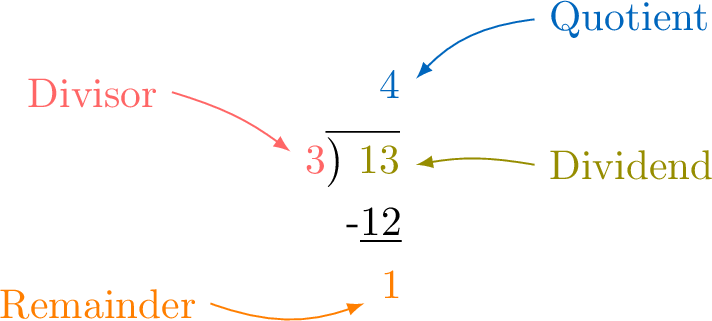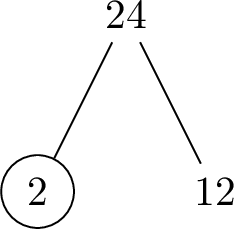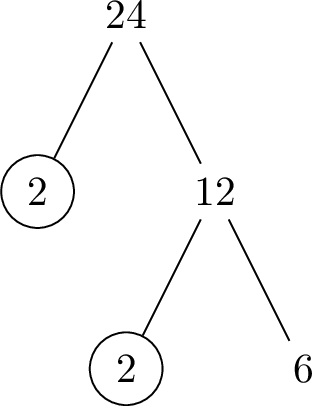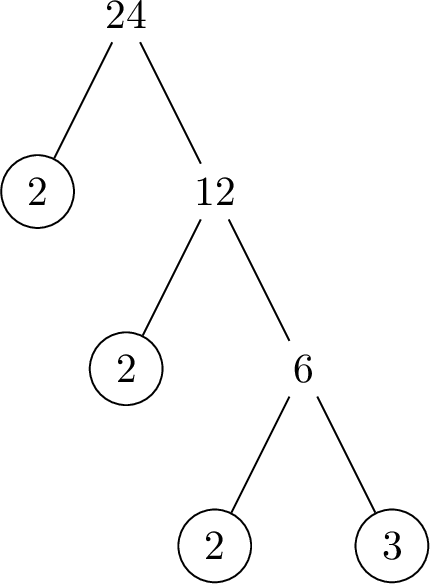Properties of Integers
Division with Remainders
Hugo has \(\textcolor{olive}{13}\) marbles to divide evenly into \(\textcolor{colordef}{3} \) groups. 
How many marbles will be in each group, and how many will be left over?


Theorem Division with Remainder
For any two whole numbers, a \(\textcolor{olive}{\text{dividend}}\) and a non-zero \(\textcolor{colordef}{\text{divisor}}\), there exists a unique \(\textcolor{colorprop}{\text{quotient}}\) and a unique \(\textcolor{orange}{\text{remainder}}\) that are also whole numbers, such that: $$\begin{array}{ccccccccl} \textcolor{olive}{13} &=& \textcolor{colordef}{3}& \times& \textcolor{colorprop}{4}&+&\textcolor{orange}{1} & \text{with }& \textcolor{orange}{1}\lt \textcolor{colordef}{3}\\ \textcolor{olive}{\text{Dividend}}&=& \textcolor{colordef}{\text{Divisor}}&\times&\textcolor{colorprop}{\text{Quotient}}&+&\textcolor{orange}{\text{Remainder}}& \text{with }& \textcolor{orange}{\text{Remainder}}\lt \textcolor{colordef}{\text{Divisor}} \end{array} $$ 

Divisibility
Definition Divisible
A whole number is said to be divisible by another non-zero whole number if the remainder is zero when you divide the first number by the second number. In this case, we say that the second number is a divisor of the first number.
Example
Is \(10\) divisible by \(5\)?
Yes, \(\textcolor{olive}{10}\) is divisible by \(\textcolor{colordef}{5}\) because the remainder of the division is \(\textcolor{orange}{0}\): \(\textcolor{olive}{10} = \textcolor{colordef}{5} \times \textcolor{colorprop}{2} + \textcolor{orange}{0}\).
Example
Is \(13\) divisible by \(5\)?
No, \(\textcolor{olive}{13}\) is not divisible by \(\textcolor{colordef}{5}\) because the remainder of the division is \(\textcolor{orange}{3}\): \(\textcolor{olive}{13} = \textcolor{colordef}{5} \times \textcolor{colorprop}{2} + \textcolor{orange}{3}\).
Definition Multiple
A whole number is said to be a multiple of another non-zero whole number if the first number can be obtained by multiplying the second number by some whole number. In other words, the first number appears in the multiplication table of the second number. In this case, we say that the second number is a factor of the first number.
Example
Is \(10\) a multiple of \(5\)?
Yes, \(10\) is a multiple of \(5\) because \(5 \times 2 = 10\). So \(5\) is a factor of \(10\).
Theorem Divisible \(\Leftrightarrow\) Multiple
For two whole numbers, the first number is divisible by the second number if and only if the first number is a multiple of the second number.
This is a direct consequence of the uniqueness of the quotient and remainder in the division with remainder theorem. If the remainder is zero, then the dividend is exactly the product of the divisor and the quotient, which is the definition of a multiple. Conversely, if a number is a multiple of another, then by definition it can be written as a product, implying a zero remainder upon division.
Example
Is \(1000\) divisible by \(10\)?
Yes, as \(1000 = 100 \times 10\), \(1000\) is a multiple of \(10\). Therefore, \(1000\) is divisible by \(10\).
Divisibility Criteria
Divisibility criteria are methods that allow us to quickly determine if a whole number is divisible by another whole number without performing long division. These rules are useful for simplifying calculations and understanding number properties. Here are some common divisibility criteria:
Proposition Divisibility Criteria for 2 and 5
- A number is divisible by 2 if its last digit is even (0, 2, 4, 6, or 8).
- A number is divisible by 5 if its last digit is 0 or 5.
Example
Determine whether \(946\) is divisible by \(2\).
\(946\) is divisible by \(2\) because its last digit is \(6\), which is even.
Example
Determine whether \(947\) is divisible by \(5\).
\(947\) is not divisible by \(5\) because its last digit is \(7\), which is not \(0\) or \(5\).
Proposition Divisibility Criteria for 3 and 9
- A number is divisible by 3 if the sum of its digits is divisible by 3.
- A number is divisible by 9 if the sum of its digits is divisible by 9.
Example
Determine whether \(948\) is divisible by \(3\).
\(948\) is divisible by \(3\) because the sum of its digits, \(9 + 4 + 8 = 21\), is divisible by \(3\) (\(21 = 3 \times 7\)).
Example
Determine whether \(948\) is divisible by \(9\).
\(948\) is not divisible by \(9\) because the sum of its digits, \(9 + 4 + 8 = 21\), is not divisible by \(9\) (\(21 = 9 \times 2 + 3\)).
Proposition Divisibility Criteria for 4
A number is divisible by 4 if the number formed by its last two digits is divisible by 4.
Example
Determine whether \(917\) is divisible by \(4\).
\(917\) is not divisible by \(4\) because the number formed by its last two digits, \(17\), is not divisible by \(4\) (\(17 = 4 \times 4 + 1\)).
Numbers 1 and 0
Zero (0) and one (1) are very special numbers which have important properties.
Imagine you have 3 apples in your basket.

Well, if you get no extra apples, you still have exactly the same number you started with. You still have 3 apples.This is what the Additive Identity Property tells us: adding zero doesn't change the amount. In mathematics, we write this as:$$3+0=3$$And this is true for any number of apples, or any number at all! Adding zero to any number leaves the number unchanged.
Proposition Additive Identity Property
Adding \(0\) to any number results in the number itself. For any number \(a\),$$0+a=a$$
Example
\(7+0=7\)
- Multiplying by \(0\):
- Any number multiplied by 0 always results in 0.
- For example, \(5 \times 0 = 0 + 0 + 0 + 0 + 0 = 0\).
- Dividing by \(0\):
- Division by \(0\) is undefined in mathematics because it leads to a contradiction.
- For example, if \(x = 10 \div 0\), then \( x \times 0 = 10\). But this is impossible because \(0 \times x\) is always 0, not 10.
Proposition Multiplying by \(0\)
For any number \(a\),$$a\times 0 =0$$
Proposition Dividing by \(0\)
Division by \(0\) is undefined.
Imagine you have a basket with \(\textcolor{olive}{4}\) delicious apples.

Well, if you have just 1 basket, you have exactly the same number of apples as in that basket. You still have 4 apples.This is what the Multiplicative Identity Property tells us: multiplying by one doesn't change the amount. In mathematics, we write this as:$$1 \times 4 = 4$$And this is true for any number of apples, or any number at all! Multiplying any number by one leaves the number unchanged.
Proposition Multiplicative Identity Property
Multiplying \(1\) by any number results in the number itself.
For any number \(a\),$$ 1\times a=a$$
For any number \(a\),$$ 1\times a=a$$
Example
\(1\times 7=7\)
Prime number
Definition Prime Number
Un nombre premier est un nombre entier plus grand que 1 qui a seulement deux diviseurs différents : 1 et lui-même.
Un nombre entier plus grand que 1 qui n'est pas premier est appelé un nombre composé.
Un nombre entier plus grand que 1 qui n'est pas premier est appelé un nombre composé.
Example
State whether \(6\) is a prime number.
As \(2\times 3=6\), \(6\) is not a prime number because it is divisible by \(2\) and \(3\), in addition to \(1\) and \(6\). So \(6\) is a composite number.
Example
State whether \(5\) is a prime number.
\(5\) is a prime number because it is divisible entirely only by \(1\) and \(5\). We cannot divide it entirely by \(2, 3\) or \(4\) (there would be a remainder).
Proposition First 25 Prime Numbers
Here is the list of the first 25 prime numbers:$$ 2, 3, 5, 7, 11, 13, 17, 19, 23, 29, 31, 37, 41, 43, 47, 53, 59, 61, 67, 71, 73, 79, 83, 89, 97$$
Prime factorization
Definition Prime Factorization
Prime factorization is writing a number as a product of only prime numbers. In other words, it's finding which prime numbers you need to multiply together to get the original number.
Example
Find the prime factorization of \(12\).
The prime factorization is \(12=2\times 2 \times 3\).
The order is not important. You can write \(12=3\times 2 \times 2\).
The prime factorization is not \(12=2\times 6\) as \(6\) is a composite number.
The order is not important. You can write \(12=3\times 2 \times 2\).
The prime factorization is not \(12=2\times 6\) as \(6\) is a composite number.
Method Factor Tree
The Factor tree method involves breaking down a composite number into smaller factors, then breaking down those factors further until you have only prime factors.
- Place the number at the top of the factor tree.
- Check if the number is prime.
- If the number is prime: Circle it. You are done with this branch.
- If the number is composite: Factorize it into two smaller factors. Write these two factors as branches below the number. Repeat step 2 for each of these new factors.
- The prime factorization is the product of all circled prime numbers on the tree.
Example
Find the prime factorization of \(24\).
- Step 1:

- Step 2: \(24\) is a composite number. \(24=2\times 12\).

- Step 3: \(12\) is a composite number. \(12=2\times 6\).

- Step 4: \(6\) is a composite number. \(6=2\times 3\).
